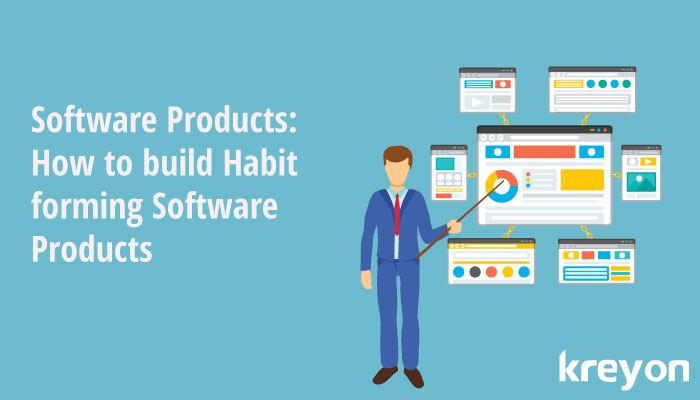Software Products: How to build Habit forming Software Products

Companies are looking to build software products that users love. Everything around is driven by automation and software products. Businesses are investing more in technology to secure their future. Everyone understands the importance of technology and building a software product is a sure fire way to great success.
As per Harvard Business School professor Clayton Christensen, there are over 30,000 new consumer products introduced every year, and 95 percent of them fail. The failure rates of software products is equally alarmingly. But what makes some products standout? For e.g. there are many email clients, but Gmail beats them because it is a habit forming product. Whatsapp, FB, Google Search & Amazon are all in the same league.
Software product development is a complex art. It requires great expertise and continuous efforts. It is hard enough to build a scalable and quality product, but even harder to make it a habit forming one. Here’s a look at what it takes to build habit forming software products.
1. Solve Pain Points
The most important software products are like pain killers for clients, they cannot do without them. So, is your product addressing the most significant challenges for the clients or is it only good to have.

For e.g. a software product that takes care of accounting for an organisation is like a pain killer. The compliance obligations make it imperative for businesses to use software products that can handle things end to end.
Before building a great software product, you need to understand your space deeply. You need to understand your users and why they will use your product. A software product that solves a problem and is rewarding for users is likely to be used more often.
2. Product Roadmap & Evolution
Have you seen how some software products keep evolving? A product roadmap is a must for it to serve value in the long term. The technological developments happen fast. If you build things that get outdated with time, customers will use something else.
Habit forming products keep their evolution curve. They cater to changing user needs and adopt as per latest developments in their field. For e.g. Gmail recently launched features that help users to write emails now.
A long term product roadmap makes customers confident that they are not wasting their time on your product. They know that the product they use will continue to evolve as per demands of the future.
3. Triggers
A trigger prompts users to take some action or what to do next. In simple words, these products drive users to either do their day to day tasks or helps them relax. A habit forming product makes an association with the user and the product. The user views the product as a source of relief.

For example, a software product that takes care of the accounting needs of an organisation sends management reports to the executives. It sends reminders for important dates and triggers user actions for meeting its compliance needs.
These habit forming products make it absolutely easy for users to take actions. The executives and users can take action without thinking much. It makes things effortless.
4. Reward Users
No one can force users to adopt a system. These days are long over. A product that rewards it users and helps them accomplish something useful for their purpose will be valued. Social media sites use gamification models where people are driven by likes, shares and followers etc to entice them to their products more.
Software products that rewards users create habitual patterns for their users. For e.g. a business management software helps the executives approve or reject requests pending for them to get their work done. If it helps them generate reports that they can present to their supervisors and help them accomplish their tasks with ease.
5. Time & Efforts
A software product that is developed for business must provide results for its users. So, everytime user invests time and effort into the product, they value the product more. An association with the product is developed and users come back again.

Research has shown that users love the product more when they have learnt or spent time on it. Companies need to ensure that users benefit from the products, everytime they use the product.
6. Data & Security
Users are more likely to use software products, which come from an authentic source. The data and security are consequential in users choosing software products. When users understand that their data is safe and secure, they can use the products.
Data and security help to establish trust with the users and customers. When the fundamental aspects are found wanting, it leads to regulatory issues that may be detrimental in the long run. Software products must be fool proof and guard their users against malicious activities.
7. Product Experience
The product experience for users involves intuitive workflow, minimal designs, and help users accomplish things they want. A rich product experience is crucial to winning users.
While physical products lose their sheen with time, software products are designed to get better. Take the example of an online store like Amazon, the functionality you get today is far better than say 5 years ago.

When products are designed elegantly, engineered to perfection and help users get things moving, they become sticky. Users spend more time on the products and they even recommend it to others.
Kreyon Systems has great expertise in software product development with the latest technologies & dynamic business needs. If you’re looking for any help for building a software product, please reach out to us.
